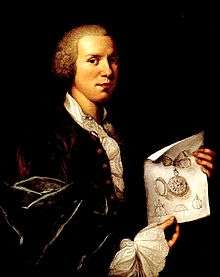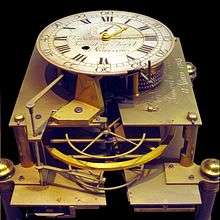Ferdinand Berthoud
| Ferdinand Berthoud | |
|---|---|
 | |
| Born |
19 March 1727 Plancemont[*] |
| Died |
20 June 1807 Groslay |
| Occupation | watchmaker, Encyclopédistes |
| Awards | Knight of the Legion of Honour[*], Fellow of the Royal Society |
Ferdinand Berthoud (18 March 1727, Plancemont-sur-Couvet, Val-de-Travers, Canton of Neuchâtel – 20 June 1807, Groslay) was a French watchmaker and scientist. He was awarded the title of Master Watchmaker in Paris in 1753. He occupied the position of Horologist-Mechanic by appointment to the King[1] and the Navy and left behind him an exceptionally broad body of work, notably in the field of marine chronometers. He succeeded the pioneering work of Henry Sully.[2] At the king's insistence he travelled to England to view the chronometers of John Harrison.
Together with his great rival, Pierre Le Roy, Berthoud contributed to the development of the chronometer, .[1] He was made a member of the Institute of France and elected a Fellow of the Royal Society of London in 1764.[3] Among other works he wrote Essai sur l'horlogerie in 1763.
He died in 1807 at his home in Groslay near Montmorency, Seine et Oise. He had married twice, firstly Mademoiselle Chati of Cean, and then Mademoiselle Dumoustier of Saint Quentin, but had no children. His business passed to his nephew, Louis Berthoud (1759–1813).
History
Ferdinand Berthoud settled in Paris on April 16, 1745 at the age of 18, a move that enabled him to perfect his knowledge of the watchmaking-clockmaking profession. He is generally considered to have entered the workshop of Julien Le Roy. Ferdinand Berthoud rapidly acquired a reputation for technical competence and achieved recognition for his innovations in his field.
From 1755 onwards, he was entrusted with writing several reference articles on horology for the “Methodical Encyclopaedia” published between 1751 and 1772 under the supervision of Diderot and d’Alembert. Ferdinand Berthoud published his first specialised book in 1759, entitled L’art de conduire et de régler les pendules et les montres, à l’usage de ceux qui n’ont aucune connaissance d’horlogerie[4] (The art of operating and adjusting clocks and watches for those who have no horological knowledge). This was a popular scientific work that proved a great success and was translated into several languages and then repeatedly re-edited during the 18th and 19th centuries.
On December 13, 1760, Ferdinand Berthoud submitted to the French Royal Academy of Science a Mémoire sur les principes de construction d’une Horloge de Marine (Dissertation on the construction principles of a marine chronometer), the famous Marine Chronometer No. 1, whose construction was completed at the start of 1761.
He made marine clocks to calculate longitude at sea. In 1764, by order of the King, the Academy charged two of its members, Duhamel du Monceau and Abbot Chappe d’Auteroche with putting the Marine Chronometer No. 3 by Ferdinand Berthoud to trial at sea. They set off from Brest aboard the corvette L’Hirondelle on October 7 that year, accompanied by Ferdinand Berthoud. The mission report, read by Abbot Chappe d’Auteroche to the Academy on November 14, was never published, an exceptional occurrence. In his Traité des horloges marines (Treatise on marine chronometers), Berthoud insinuates that this omission was due to Duhamel du Monceau whose nephew, Fougeroux de Grandlieu, having served as lieutenant during this expedition, died several days after the ship’s return.
Ferdinand Berthoud was appointed Horloger du roi (Horologist-Mechanic by appointment to the King and the Navy) in 1770. He was also named a member of the Institute right from the time of its creation in 1795. Berthoud had meanwhile become a member of the Royal Society on February 16, 1764.
He is regarded as one of the inventors of the marine chronometer that served to determine longitude at sea necessary to navigation.
His nephew Louis Berthoud, also distinguished himself as a horologist.
Ferdinand Berthoud married Henriette Chatry de La Fosse, and later Marie Adélaïde Dumoustier.
Works and Influence
Obliged to work as a companion-horologist with masters of the Parisian corporation, having failed to serve his apprenticeship under one of them, the young Berthoud managed to overcome this hurdle by drawing attention due to “his application in perfecting the art of watchmaking.”[5] He seized the possibility of making his research known at the Royal Academy of Science by submitting a sealed document describing a new construction. The approval, granted by academy members on April 26, 1752, of an equation clock that was deemed highly ingenious, marked the start of his career as a researcher, while also enabling him to lay claim to official integration into the horological community. On December 4, 1753, the King of France ordered that he should be granted the title of master,[6] authorising him to open a workshop on the Rue de Harlay, near the Place Dauphine.
In 1754, the master horologist once again submitted his inventions to the Academy. One was his first marine chronometer project. The others, examined and approved by academy members, were also equation systems: “a concentric seconds equation marking the months and days of the month, leap years, and running for 13 months without requiring rewinding”; a seconds and equation watch marking the month and days.
Before even being named a Master Watchmaker, Ferdinand Berthoud revealed the meaning he wished to give to his career: devoting himself to research and passing on his knowledge through publications and teaching. This two-fold commitment enabled him to swiftly establish himself in the scientific circles of his era. Several articles of the Encyclopaedia supervised by Diderot were entrusted to him, particularly the “Equation” article. In 1759, he published a popular work that would prove a success: L’Art de conduire et de régler les pendules et les montres. A l’usage de ceux qui n’ont aucune connaissance d’horlogerie (The art of operating and adjusting clocks and watches for those who have no horological knowledge).[7] In 1763, his voluminous treatise, L’Essai sur l’horlogerie ; dans lequel on traite de cet Art relativement à l’usage civil, à l’Astronomie et à la Navigation (Essay on Horology, dealing with this Art relating to civilian use, astronomy and navigation)[8] was also favourably received.
The year 1763 marked a turning point in Berthoud’s career, which was now closely linked with the progress of maritime navigation. The Academy of Science was once again both a witness and a support in this realm: the horologist had two sealed documents describing Marine Chronometer no. 1 delivered to it in 1760 and 1761.[9] Convinced by the watchmaker’s competence, the academy members persuaded the French Navy Ministry to send Berthoud to examine Harrison’s marine chronometer. This turned out to be an opportunity for him to be appreciated by his peers and appointed as a foreign associate of the Royal Society on February 17, 1764. On August 29 that same year, Ferdinand Berthoud once again submitted a document relating to the “construction of a marine clock…”. It was to be the last: Berthoud was by then certain to have found the path of his research and to have the possibility of requesting official backing.
The cadence for his activities was set by projects relating to detailed requests. He proposed the construction of two marine clocks on May 7, 1766: these were Nos 6 and 8 exhibited at the French Arts & Crafts Museum. After successful experimentation with these clocks, Ferdinand Berthoud was awarded the title “Brevet d’horloger Méchanicien du Roi et de la Marine ayant l’inspection de la construction des Horloges marines” (warrant of Horologist-Mechanic by appointment to the King and the Navy responsible for the construction of marine clocks), specifically created for him on April 1, 1770.
From that point onward, he set aside the management of his workshop-boutique to dedicate himself to research, stating in 1792: “it was above all from 1770 onwards that I devoted myself wholeheartedly to this aspect and in some ways departed from my public work."
A tenacious experimenter, a clever and daring builder and an inventor keen to share his knowledge, Ferdinand Berthoud not only played a part in the advancement of watchmaking, but also fostered the use of precision clocks in the scientific endeavours of his era, thereby contributing to their progress. The titles, privileges and testimonies of recognition punctuating his career, between the reign of Louis XV and the First Empire, followed by the tributes and the studies devoted by critics to his work right the way through to the present day reflect the importance of his place in the longstanding quest for precision since Huyghens’ discoveries through to those of Guillaume.
Main clocks
-

Berthoud marine clock no.2, with motor spring and double pendulum wheel, 1763.
-

Berthoud marine clock no.3 1763.
-

Berthoud chronometer no.24 (1782).
-

Gilt-bronze mantel clock, dial signed Ferdinand Berthoud (Château de Compiègne).
Works
· L’Art de conduire et régler les pendules (The art of operating and adjusting clocks and watches for whose who have no horological knowledge), 1759 ;
· Essai sur l’horlogerie (Essay on horology), 1763 and 1786 ;
· Traité des horloges marines (Treatise on marine chronometers), 1773 (Read online) ;
· De la mesure du temps ou supplément au Traité des horloges marines et à l’Essai sur l’horlogerie (The measurement of time or a supplement to the treatise on marine chronometers and the Essay on horology), 1787 (Read online)
· Traité des montres à longitude (Treatise on longitude watches), 1792 ;
· Histoire de la Mesure du temps par les horloges 1 & 2 (The history of time measurement with clocks), 1802.
Exhibitions
An exhibition entitled Ferdinand Berthoud, horloger du roi et de la marine (Horologist-Mechanic by appointment to the King and to the Navy) was devoted to him by the Musée International d’Horlogerie in La Chaux-de-Fonds in 1984, and subsequently at the Musée national de la Marine (in France) from January 17, 1985 to March 17, 1985.
The work of Ferdinand Berthoud is also permanently exhibited in a number of museums around the world, notably in France at the CNAM, in Switzerland at the MIH and in London’s British Museum.
Notes
- 1 2 Britten's Watch & Clock Makers' Handbook Dictionary & Guide Fifteenth Edition p.122
- ↑ Chisholm 1911.
- ↑ "Library and Archive Catalogue". Royal Society. Retrieved 13 December 2010.
- ↑ Berthoud, Ferdinand (1727-1807) (1811-01-01). L'art de conduire et de régler les pendules et les montres , à l'usage de ceux qui n'ont aucune connaissance d'horlogerie ; suivie d'une Indication des règles, observations et calculs, pour l'usage des montres astronomiques, etc. Par M. Ferdinand Berthoud,... Quatrième édition, augmentée d'une planche et de la maniére de tracer la ligne méridienne du tems moyen.
- ↑ "FERDINAND BERTHOUD | An article by Cartherine Cardinal". www.ferdinandberthoud.ch. Retrieved 2016-01-13.
- ↑ "The Personality | Ferdinand Berthoud". FERDINAND BERTHOUD. Retrieved 2016-01-13.
- ↑ Berthoud, Ferdinand (1811-01-01). L'art de conduire et de régler les pendules et les montres: à l'usage de ceux qui n'ont aucune connaissance d'horlogerie : suivie d'une indication des règles, observations et calculs, pour l'usage des montres astronomiques, etc (in French). Courcier.
- ↑ "Essai sur l'horlogerie : dans lequel on traite de cet art relativement à l'usage civil, à l'astronomie et à la navigation, en établissant des principes confirmés par l'expérience, dédié aux artistes & aux amateurs : Berthoud, Ferdinand, 1727-1807 : Free Download & Streaming". Internet Archive. Retrieved 2016-01-13.
- ↑ "Horloge marine n°1 par Ferdinand Berthoud". Musée des arts et métiers. Retrieved 2016-01-13.
References
| Wikimedia Commons has media related to Ferdinand Berthoud. |
 This article incorporates text from a publication now in the public domain: Chisholm, Hugh, ed. (1911). "Berthoud, Ferdinand". Encyclopædia Britannica. 3 (11th ed.). Cambridge University Press.
This article incorporates text from a publication now in the public domain: Chisholm, Hugh, ed. (1911). "Berthoud, Ferdinand". Encyclopædia Britannica. 3 (11th ed.). Cambridge University Press.